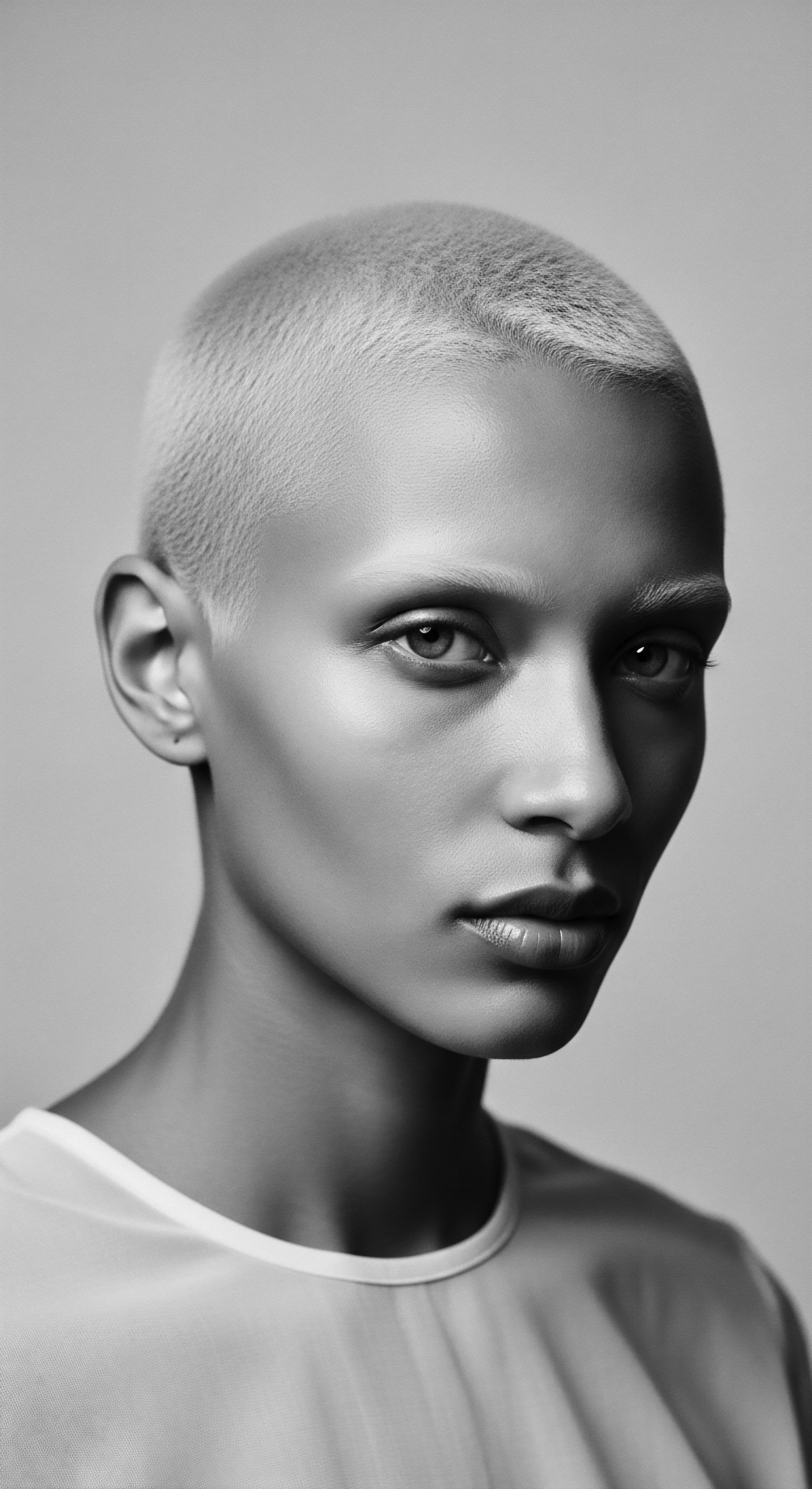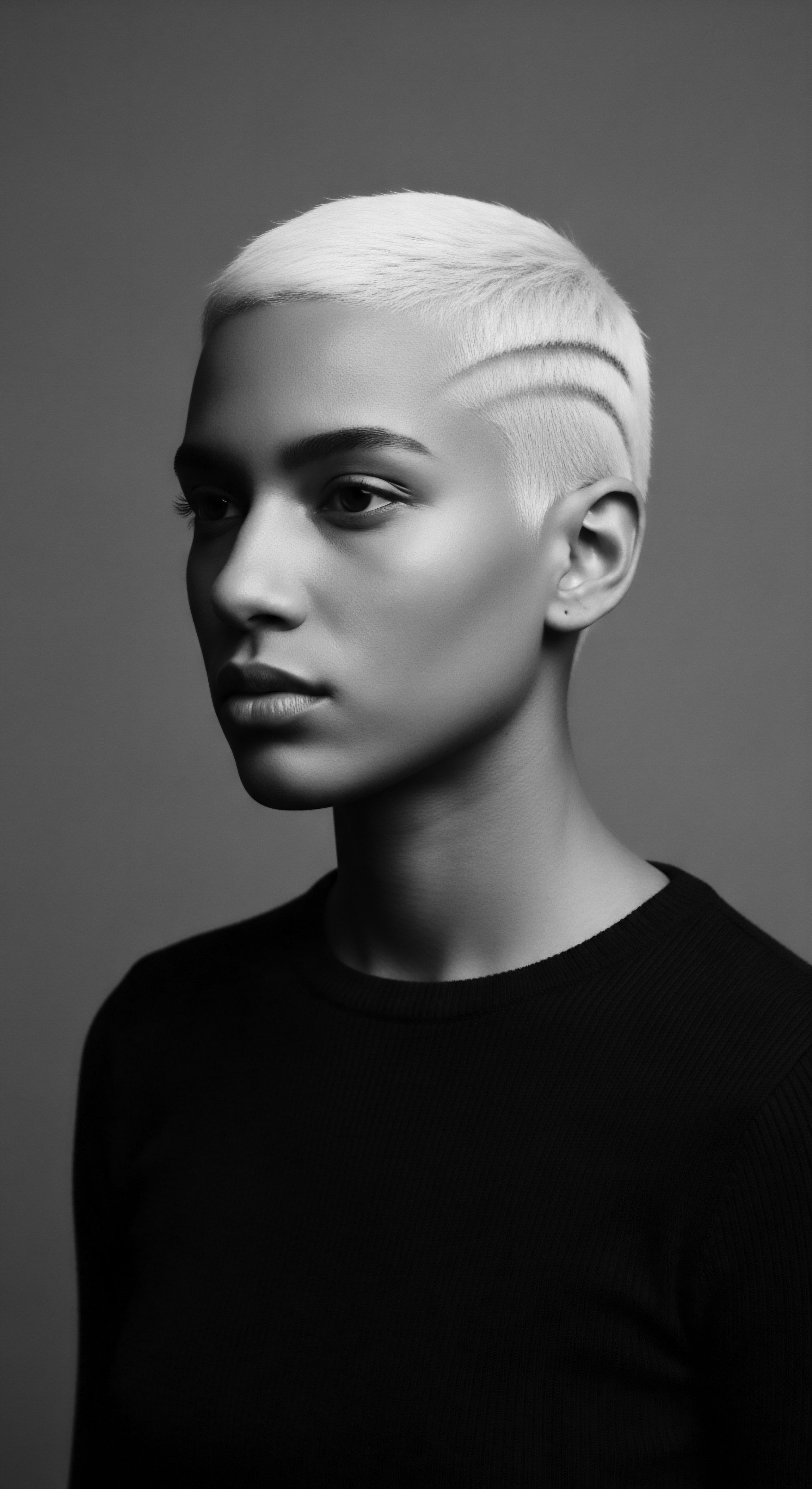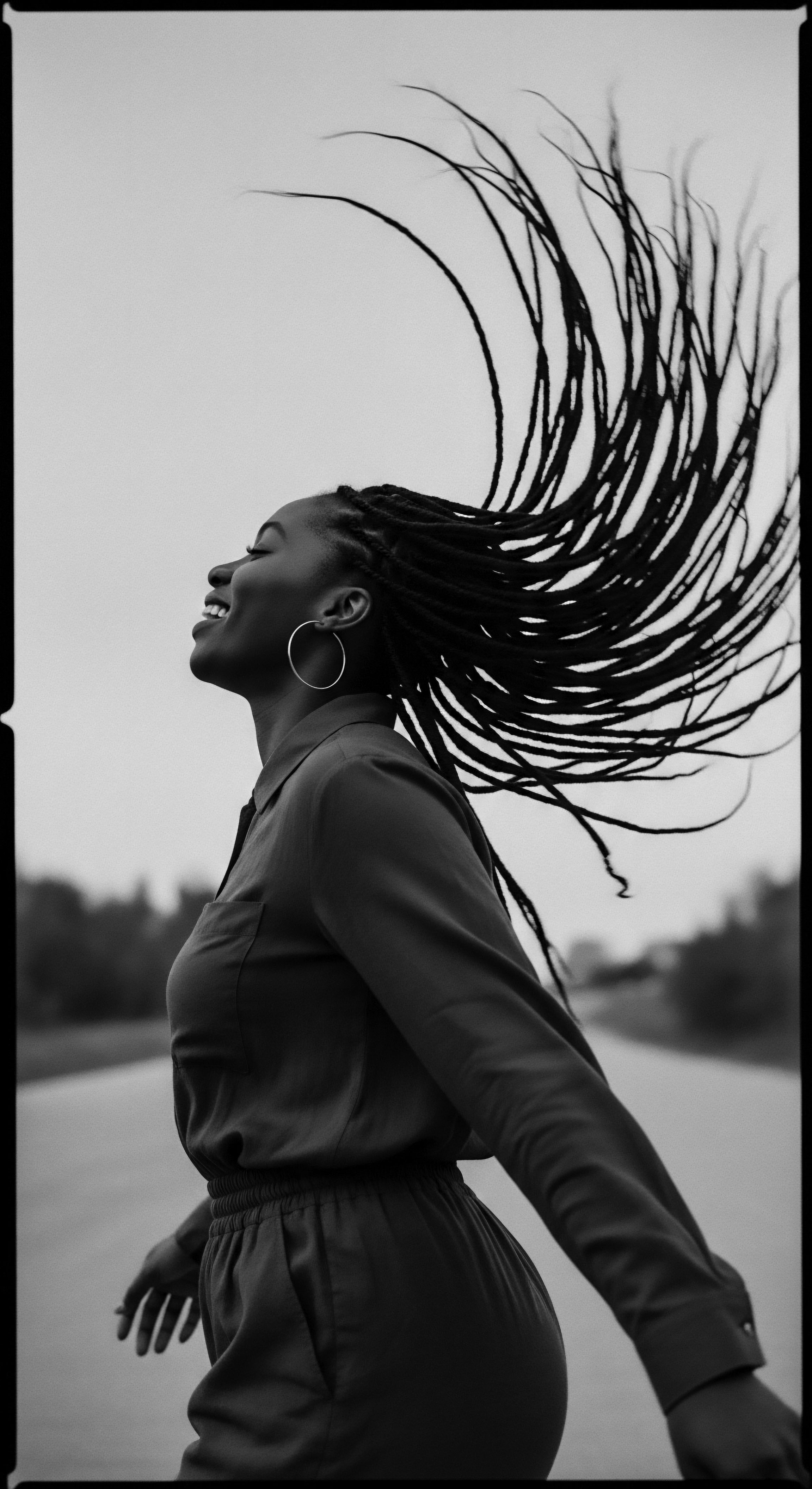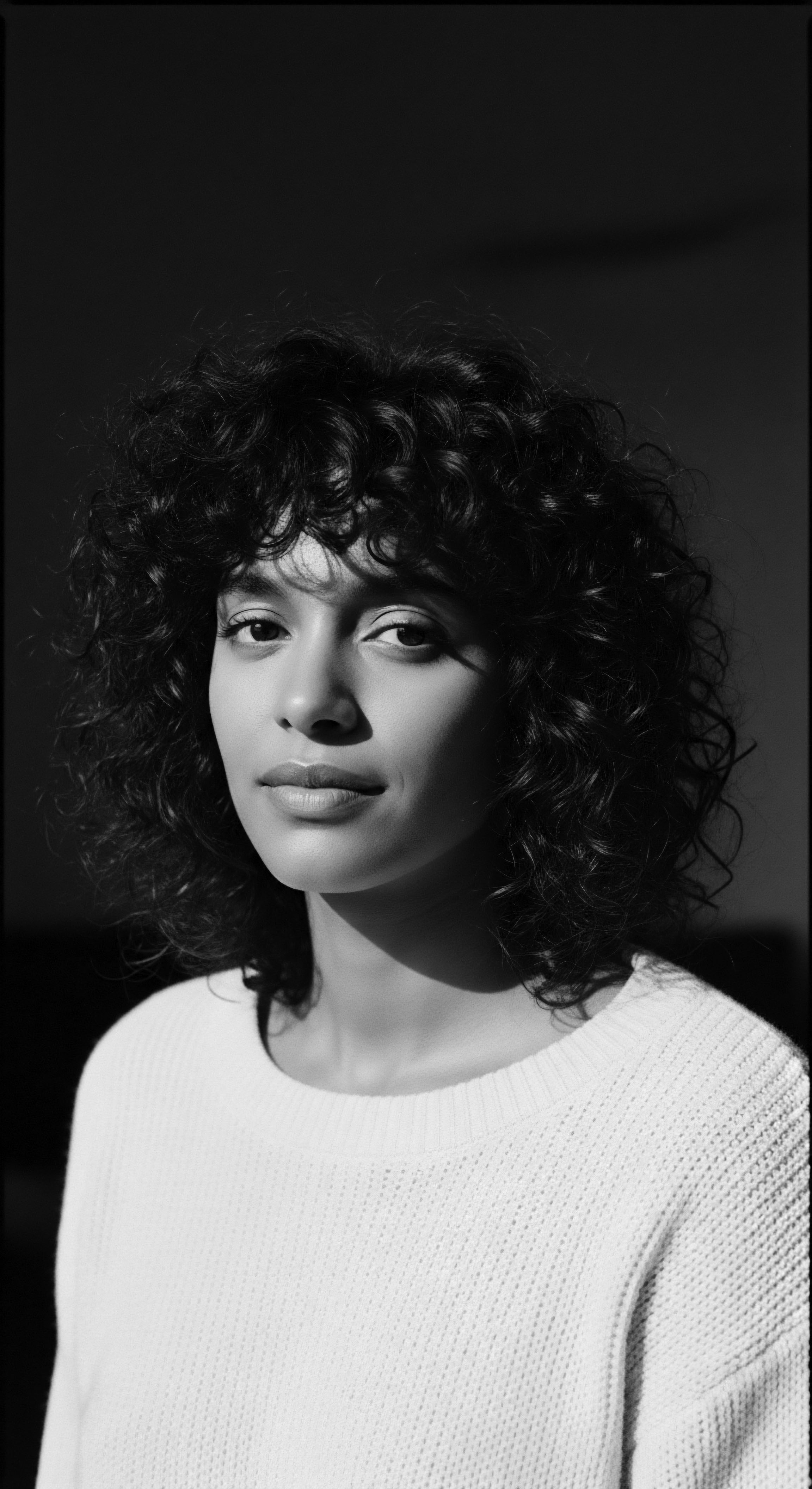
Roots
Look closely at the very fabric of our being, and there, in the resilient helix of a strand, you will find echoes of generations. For those with textured hair, this connection runs deeper than epidermal layers; it courses through the bloodstream of cultural memory. The question of whether conscious consumption can truly uphold the future of hair heritage is not an abstract inquiry.
It lives within the choices we make daily, the products we select, and the stories we honor. It is about recognizing our hair, in all its coiling, spiraling, and zig-zagging glory, as a living archive, a sacred trust passed down.

The Genesis of a Strand ❉ Ancestral Understanding
Long before the advent of microscopes, our ancestors possessed an intuitive, profound understanding of hair’s capabilities. Their knowledge, passed through oral traditions and hands-on teaching, spoke of hair not merely as appendage, but as a conduit. For many West African ethnic groups, hair served as a spiritual antenna, a visible marker of tribal identity, social status, and marital standing. The very act of caring for hair often transcended basic hygiene; it became a ritual, a communal gathering.
Early practitioners observed that hair, much like a thriving vine, required specific nourishment, gentle handling, and protection from harsh elements. This foundational wisdom forms the earliest stratum of what we might now term conscious consumption – a deep awareness of how natural resources interacted with the body, and how those interactions shaped communal well-being and identity.
Hair, for many ancestral communities, was a living chronicle, a direct connection to spiritual realms and societal narratives.

Understanding the Curl ❉ A Heritage of Classification?
Modern systems attempt to categorize textured hair with numeric and letter codes, yet our forebears had their own classifications. These were often rooted in the visible patterns and tactile qualities of the hair, but more so, they were tied to the specific tribal and regional expressions of beauty and identity. A style might declare a woman’s marital status in the Mende tradition, or a man’s warrior prowess among the Maasai.
- Kinky ❉ Often described by its tight, zig-zagging coils that defied gravity.
- Coily ❉ Displaying distinct, spring-like spirals that offered remarkable elasticity.
- Wavy ❉ Hair that presented S-shaped patterns, flowing with a graceful movement.
These descriptive terms, though simple, spoke volumes within their communal contexts, guiding care practices and adornment. The collective knowledge about what nourished each type, what styles suited it, and what messages it conveyed, was a shared inheritance.

Lexicon of Legacy ❉ Words for Our Hair
Every culture holds its own lexicon for hair, and within the diaspora, these terms often carry the weight of both historical beauty and historical struggle. From the Wolof word for hair, “ñuul,” to the various Patois terms for different textures, language itself reflects a legacy of how hair is perceived and cared for. These words are not static; they evolve, reflecting the ongoing journey of self-acceptance and pride within Black and mixed-race communities. Understanding these terms, both ancient and contemporary, creates a vocabulary for conscious engagement with our hair’s story.

Cycles of Life ❉ Hair Growth Through Time
The growth cycle of textured hair, from its anagen (growing) phase to its telogen (resting) phase, was intuitively understood by ancestral communities. They observed seasonal changes, dietary impacts, and the effects of childbearing on hair density and length. Herbal remedies, nutrient-rich foods, and protective styling techniques were developed to support these cycles, aiming for length retention and overall hair vitality. This ancestral wisdom formed a practical application of conscious consumption – a deep understanding of natural resources and their application to optimize the hair’s inherent life rhythm.
For instance, the widespread use of natural butters and oils, like shea butter, throughout West Africa was not arbitrary. These substances were chosen for their moisturizing and protective qualities, their efficacy confirmed over countless generations (Byrd & Tharps, 2001, p. 25). The cultivation and trade of such ingredients represented an early form of supply chain, a conscious effort to acquire and apply resources beneficial to collective well-being and appearance.

Ritual
The journey of textured hair through history is marked by profound rituals—practices born of necessity, artistry, and spiritual conviction. These are not merely acts of grooming; they represent a continuous dialogue between the individual and their ancestral lineage, a performance of identity that spans continents and centuries. Conscious consumption, in this context, reaches beyond product ingredients to encompass the very intent behind our styling choices. It demands an appreciation for the narratives woven into each braid, coil, and twist, recognizing them as living connections to those who came before.

Protective Styles ❉ An Ancestral Shield
Protective styles hold a place of profound significance in textured hair heritage. Their origins stretch back to antiquity, serving pragmatic purposes of cleanliness, protection from harsh environments, and the prevention of tangling. More deeply, they were powerful statements of identity, status, and communication. In many pre-colonial African societies, specific braiding patterns could denote age, marital status, tribal affiliation, or even a person’s readiness for war.
The deliberate cultivation of these styles required patience, skill, and communal participation. This practice of styling, often taking hours or days, was a shared ritual, a time for stories, songs, and the transmission of generational wisdom. The materials used, from natural fibers for extensions to plant-based pigments for adornment, were consciously sourced from the environment. These acts, though seemingly simple, embody an early form of conscious consumption ❉ valuing and preserving the integrity of the hair and its cultural expressions.
The enduring practice of protective styling stands as a living testament to ancestral ingenuity and communal bonds.

Defining Beauty ❉ Natural Textures and Rituals
The very definition of beauty, for textured hair, has been a contested terrain throughout history. Yet, within our heritage, there exist countless rituals dedicated to honoring natural textures. These practices, passed through families, centered on enhancing the innate beauty of coils and curls without altering their fundamental structure. Techniques like finger coiling, knotting, or sectioning to define patterns were often accompanied by the application of rich, natural emollients like shea butter, coconut oil, or various plant infusions.
These were not just conditioners; they were elixirs, carefully prepared and applied with purposeful hands. The deliberate choice to work with the hair’s natural inclination, rather than against it, represents a deeply conscious approach. It speaks to a self-acceptance that was, at times, revolutionary in the face of societal pressures to conform to Eurocentric beauty standards.

Adornment and Identity ❉ Wigs and Extensions Across Generations
The use of wigs and hair extensions, often perceived as modern trends, has deep historical and cultural roots in African heritage. Ancient Egyptians, for example, wore elaborate wigs made from human hair, plant fibers, or wool, signifying status, wealth, and spiritual connection. In West African societies, hairpieces made from braided extensions or woven natural fibers were integral to ceremonial attire and daily adornment, offering versatility and protecting natural hair. These were meticulously crafted, often embellished with cowrie shells, beads, or gold.
The creation and wearing of such pieces represented a conscious investment in self-expression and cultural continuity. Modern extensions, when sourced ethically and used to honor heritage styles, continue this lineage, allowing for artistic expression while protecting underlying natural hair.
| Historical Practices Elaborate braided styles signifying social status in ancient African kingdoms. |
| Contemporary Conscious Link Supporting artisans creating traditional hair accessories, or choosing stylists skilled in ancestral braiding techniques. |
| Historical Practices Using natural pigments and plant extracts for hair color or adornment. |
| Contemporary Conscious Link Opting for plant-based dyes or products with ethically sourced natural ingredients. |
| Historical Practices Communal hair grooming as a bonding ritual and knowledge transfer. |
| Contemporary Conscious Link Participating in natural hair meetups or supporting Black-owned hair businesses that emphasize community education. |
| Historical Practices The choices we make about hair products and styles echo ancestral practices of self-care and cultural affirmation. |

Tools of Tradition ❉ Shaping Our Hair’s Story
The tools used for hair care and styling are as much a part of our heritage as the styles themselves. From intricately carved wooden combs to simple bone picks, these implements were not just functional; they were often artistic expressions and heirlooms. Many African combs, for instance, were adorned with symbolic motifs, embodying spiritual meaning or narratives of tribal identity. The craftsmanship involved in creating these tools speaks to a conscious investment in the hair care ritual itself.
When considering conscious consumption today, this means seeking out tools that are durable, sustainably made, and ideally, created by artisans who understand the unique needs of textured hair. It means moving beyond disposable plastic and investing in quality implements that can become part of one’s own personal legacy, tools that respect the hair as much as the hand that wields them.
The conscious consumer, therefore, considers not only the end product but the entire ecosystem that brings it into being ❉ the hands that harvest the ingredients, the minds that formulate the products, and the intentions behind their creation.

Relay
The enduring vitality of textured hair heritage is not static; it is a dynamic relay, a continuous transmission of knowledge, practices, and identity from one generation to the next. This relay requires a conscious effort, a mindful engagement with the past, and an intentional shaping of the future. The conversation around conscious consumption for textured hair reaches its zenith here, where the science of hair meets the depth of cultural practice, and ancestral wisdom informs contemporary choices. It is about understanding that every product selected, every ritual performed, carries an opportunity to strengthen this intergenerational link, ensuring the legacy of our strands continues its resilient journey.

Crafting Regimens ❉ Echoes of Ancestral Care
Developing a personalized textured hair regimen today involves a scientific understanding of hair needs, yet its most effective blueprints often echo ancestral care. Our forebears intuitively grasped concepts of moisture retention, scalp health, and low manipulation long before these terms entered scientific discourse. For example, the layering of various plant-based oils and butters for sealing moisture was a common practice in numerous African communities, a pragmatic solution to maintaining hair hydration in arid climates. Modern regimens that advocate for leave-in conditioners, oils, and styling creams can trace their lineage back to these multi-step ancestral applications.
Conscious consumption in this sphere prompts us to investigate the origin of ingredients, favoring those whose cultivation methods respect both the earth and the communities that traditionally harvested them. It encourages a return to simplicity, recognizing that often, the most effective care lies in time-honored, natural elements.

The Nighttime Embrace ❉ A Heritage of Protection
The ritual of nighttime hair protection holds a particularly potent place in textured hair heritage. This is not a modern innovation; rather, it is a practice deeply rooted in the necessity of preserving intricate styles and protecting vulnerable strands. From the use of head wraps in ancient Nubia to the silk scarves and bonnets prevalent today, the covering of hair at night has been a consistent thread. This conscious act of securing hair before rest minimized tangling, reduced breakage against harsh bedding materials, and extended the life of styled hair.
Beyond the practical, there was often a spiritual dimension – the hair, seen as a sacred part of the body, was respectfully covered, especially during sleep, a vulnerable state. Conscious consumption in this area means choosing materials like silk or satin that honor hair integrity, and supporting producers who understand the cultural significance of these protective garments.

Alchemy of the Earth ❉ Ingredients from Our Past
The ancestral pharmacy for textured hair was a rich repository of plant-based ingredients, each chosen for its specific capabilities. Shea butter, sourced from the karite tree, was revered across West Africa for its moisturizing and healing properties. Aloe vera, native to various African regions, was used for scalp soothing and conditioning. These ingredients were often wild-harvested or cultivated with a deep respect for the land.
- Shea Butter ❉ A powerful emollient, traditionally used for sealing moisture, treating scalp conditions, and protecting hair from sun.
- Aloe Vera ❉ Applied for its soothing qualities, often used to alleviate scalp irritation and condition strands.
- Black Soap (Alata Samina) ❉ A natural cleanser, often used for gentle washing of hair and scalp.
Conscious consumption today demands a critical look at how these ancestral ingredients are sourced. Are they fair trade? Do their supply chains benefit the indigenous communities that have stewarded this knowledge for centuries? This inquiry pushes us beyond simple ingredient lists to the ethical heart of the product.

Addressing Challenges ❉ Wisdom from Our Forebears?
Textured hair presents its own set of challenges, from dryness to breakage and detangling difficulties. While modern science offers complex solutions, ancestral wisdom often provided remarkably simple, yet effective, remedies. For instance, the use of warm water rinses to open the hair cuticle for better product absorption, or the practice of detangling hair gently with fingers or wide-tooth combs while wet, are techniques validated by both ancestral observation and modern hair science.
A powerful historical example of conscious consumption supporting hair heritage can be seen in the burgeoning Black-owned beauty enterprises during the early 20th century in the United States. Figures like Madam C.J. Walker built empires by creating products specifically tailored for Black hair, often incorporating natural ingredients and traditional techniques. This was a direct response to the lack of suitable products from mainstream markets, and it was a form of economic self-determination that also affirmed Black beauty (Bundles, 2001).
These entrepreneurs provided solutions while also building wealth and fostering a sense of pride within the community, demonstrating a conscious cycle of production and consumption that prioritized the needs and heritage of textured hair. This historical period marks a profound shift, where consumption became a deliberate act of cultural and economic affirmation.
| Traditional Problem Excessive dryness and brittleness. |
| Ancestral Solution Regular application of natural butters (e.g. shea, cocoa) and oils. |
| Modern Conscious Application Seeking products with high concentrations of ethically sourced plant-based emollients, avoiding harsh sulfates. |
| Traditional Problem Tangled, matted hair after sleep. |
| Ancestral Solution Braiding or twisting hair at night, covering with head wraps. |
| Modern Conscious Application Utilizing silk or satin bonnets, pillowcases, and nighttime protective styling. |
| Traditional Problem Scalp irritation and flaking. |
| Ancestral Solution Herbal rinses (e.g. neem, fenugreek) and gentle scalp massage. |
| Modern Conscious Application Choosing sulfate-free shampoos, incorporating scalp treatments with natural extracts. |
| Traditional Problem Understanding historical remedies offers a compass for navigating contemporary hair challenges with ancestral wisdom. |

Beyond the Strand ❉ Holistic Well-Being
The connection between hair health and overall well-being, a cornerstone of ancestral wisdom, is increasingly validated by modern holistic practices. Many traditional African belief systems viewed hair as an extension of the self, intricately linked to spiritual, emotional, and physical health. A conscious consumption approach extends beyond external products to include diet, stress management, and mindful living. Choosing whole, nutrient-dense foods, practicing stress-reducing techniques, and fostering a positive self-image rooted in our hair’s heritage are all acts of conscious consumption.
They signify a commitment to a holistic approach, where the vibrancy of our strands mirrors the vitality of our entire being, a philosophy deeply embedded in our collective past. This holistic perspective views the health of the individual, and by extension, their hair, as interconnected with the health of the community and the environment.

Reflection
The soul of a strand, in its most profound sense, is not a relic of the past, but a living, breathing testament to resilience and beauty. Can conscious consumption support the future of hair heritage? Absolutely. It offers a bridge across time, connecting us to the ancient wisdom that understood hair as more than fiber.
When we choose products rooted in ethical sourcing, when we support businesses that honor our ancestral practices, when we learn the stories behind our styles and ingredients, we are not simply consuming. We are participating in a sacred relay, a continuation of knowledge and pride. Each mindful selection becomes an affirmation, a gentle whisper to the generations that preceded us, and a resounding declaration to those who will follow ❉ our hair, our heritage, lives on, vibrant and unbound.

References
- Byrd, Ayana D. and Lori L. Tharps. Hair Story ❉ Untangling the Roots of Black Hair in America. St. Martin’s Press, 2001.
- Mercer, Kobena. Welcome to the Jungle ❉ New Positions in Black Cultural Studies. Routledge, 1994.
- Sweet, James H. The Hairstyles of African Origin on Pre-Colonial Africa. Journal of African History, 1970.
- Opoku, Kwasi. African Traditional Religion ❉ An Introduction. Waveland Press, 1978.
- Hooks, Bell. Black Looks ❉ Race and Representation. South End Press, 1992.
- Akbar, Na’im. Chains and Images of Psychological Slavery. New Mind Productions, 1196.
- Ani, Marimba. Yurugu ❉ An African-Centered Critique of European Cultural Thought and Behavior. Africa World Press, 1994.
- Fanon, Frantz. Black Skin, White Masks. Grove Press, 1967.
- Collins, Patricia. African American Hair ❉ From Nappy to Natural. Essence Magazine, 2011.
- Walker, A’Lelia Bundles. On Her Own Ground ❉ The Life and Times of Madam C. J. Walker. Scribner, 2001.
